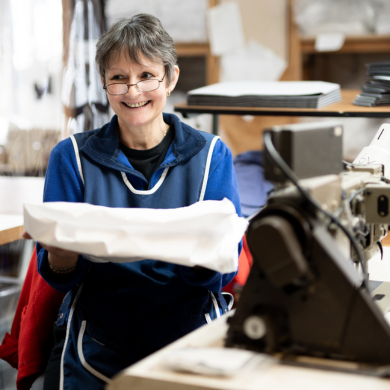
Winterschlafmodus: So bleiben Sie warm, ohne zu überhitzen
Winternächte laden dazu ein, sich unter dicken Decken einzukuscheln und der Kälte in der Wärme zu entfliehen. Doch der Grat zwischen behaglicher Wärme und drückender Hitze ist schmal. Viele kennen das frustrierende Gefühl, schweißgebadet aufzuwachen, die Decke wegzuwerfen und kurz darauf wieder zu frieren. Dieser nächtliche Hitzekreislauf im Winter stört unseren Schlaf und lässt uns am nächsten Tag müde und gereizt zurück.
Das Problem ist nicht nur die Raumtemperatur, sondern auch das Klima direkt unter Ihrer Bettdecke. Für ungestörten Schlafkomfort im Winter ist die richtige Balance entscheidend. Es geht darum, ein persönliches „Schlaf-Mikroklima“ zu schaffen, das mit Ihrem Körper harmoniert, anstatt ihn zu behindern. Ihre Körpertemperatur schwankt natürlicherweise in den verschiedenen Schlafphasen, und die falsche Bettwäsche kann diesen empfindlichen Prozess zu einem Kampf um Komfort machen.
Dieser Ratgeber bietet praktische, wissenschaftlich fundierte Schlaftipps für den Winter , damit Sie die ganze Nacht über angenehm warm bleiben.
Wir zeigen Ihnen, wie Sie sich im Bett warmhalten, indem Sie verschiedene Schichten Kleidung tragen, die richtigen Materialien auswählen und die wissenschaftlichen Grundlagen für einen erholsamen Schlaf verstehen. Wenn Sie bewusst Ihre Bettwäsche auswählen, kaufen Sie nicht nur ein Produkt, sondern investieren in Ihr Wohlbefinden und schonen gleichzeitig die Umwelt.
Warum Ihr Körper im Winter überhitzt
Es mag paradox klingen, bei Minusgraden zu überhitzen, ist aber ein häufiges Problem. Der Grund liegt oft darin, dass wir versuchen, uns mit schwerer, synthetischer Bettwäsche vor der Kälte zu schützen, die Wärme und Feuchtigkeit speichert.
Um in den Tiefschlaf zu gelangen und ihn aufrechtzuerhalten, muss Ihre Körperkerntemperatur leicht sinken. Schlafexperten zufolge liegt die ideale Schlafzimmertemperatur zwischen 16 und 18 °C. Diese kühle Umgebung signalisiert Ihrem Körper, dass es Zeit zum Ausruhen ist. Wenn Sie sich jedoch im Winter in nicht atmungsaktive Bettwäsche hüllen, staut sich Ihre Körperwärme.
Steigt Ihre Körpertemperatur, gerät Ihr Schlafrhythmus aus dem Gleichgewicht. Sie werden aus den tiefen, erholsamen Schlafphasen gerissen und fühlen sich benommen. Deshalb ist es so wichtig für Ihre Gesundheit, zu lernen , wie Sie im Winter beim Schlafen Überhitzung vermeiden .
Perfektes Gewicht und wunderbar kuschelig. Ich liebe diese Bettdecke. Die beste, die ich je benutzt habe. Ich werde meine Bettwäschekollektion dieser tollen Firma nach und nach erweitern. – Mary G
Die Wissenschaft von Temperatur und Tiefschlaf
Schlaf ist kein passiver Zustand; Ihr Körper arbeitet intensiv daran, Muskeln zu reparieren, Erinnerungen zu festigen und Hormone zu regulieren. Diese Prozesse laufen im Tiefschlaf am effizientesten ab, der sehr temperaturempfindlich ist.
Während der REM-Phase (Rapid Eye Movement) des Schlafs ist die Fähigkeit des Körpers, die Körpertemperatur zu regulieren, eingeschränkt. Man schwitzt und zittert weniger effektiv. Ist es im Schlafzimmer zu warm, kann sich der Körper nur schwer abkühlen, was häufig zum Aufwachen führt. Diese Unterbrechung verhindert die notwendige Erholung.
Regelmäßiger, erholsamer Schlaf ist grundlegend für unsere Gesundheit und beeinflusst alles, von unserem Immunsystem bis hin zu unserer geistigen Leistungsfähigkeit. In Bettwäsche zu investieren , die diesen natürlichen Prozess unterstützt, ist ein Akt der Selbstfürsorge.
So schichten Sie Bettwäsche für optimale Wärme
Eine der effektivsten Strategien für erholsamen Schlaf im Winter ist das Zwiebelprinzip. Anstatt sich auf eine einzige, schwere Bettdecke zu verlassen, ermöglichen mehrere leichtere Schichten, warme Luft einzuschließen und so für zusätzliche Isolation zu sorgen, während man gleichzeitig flexibel auf die jeweiligen Bedürfnisse reagieren kann.
Stellen Sie sich vor, Sie kleiden sich für einen Winterspaziergang: Sie würden ja auch nicht einen dicken Mantel tragen. Sie würden eine Basisschicht, eine Zwischenschicht und eine schützende Außenschicht wählen. Dasselbe Prinzip gilt für Ihr Bett. Beginnen Sie mit einem atmungsaktiven Spannbettlaken, legen Sie ein normales Laken darüber und decken Sie das Ganze mit einer Decke und einer Bettdecke ab.
Mit dieser Methode können Sie ganz einfach eine Schicht Kleidung abziehen, wenn Ihnen zu warm wird.
Für die Für die beste Bettwäsche in kalten Nächten kommt es auf die Materialien an. Naturfasern sind hier die beste Wahl. Ein atmungsaktiver Matratzentopper , beispielsweise von Putnams, bietet eine komfortable Basis, gefolgt von Bettwäsche aus Baumwolle oder Leinen und – ganz wichtig – einer Wolldecke .
Die Kraft von Wolle und Naturmaterialien
Bei Winterbettwäsche sind nicht alle Materialien gleichwertig.
Synthetische Stoffe wie Polyester und Acryl speichern zwar hervorragend Wärme, sind aber nicht atmungsaktiv. Das führt zu einem klammen, überhitzten Gefühl. Warum natürliche Materialien den Schlaf im Winter verbessern, ist einfach: Sie wirken harmonisch mit dem Körper zusammen.
Baumwolle, Leinen und Seide sind allesamt fantastische, atmungsaktive Alternativen. Im Winter ist Wolle jedoch unübertroffen. Hier erfahren Sie, warum Wolldecken die Temperaturregulierung so effektiv gestalten:
- Natürliche Temperaturregulierung: Wolle ist ein natürlicher Isolator, der sich Ihrer Körpertemperatur anpasst. Ihre Fasern bilden winzige Luftpolster, die Wärme speichern, wenn Ihnen kalt ist, und gleichzeitig Luftzirkulation ermöglichen, um Wärme und Feuchtigkeit abzugeben, wenn Ihnen warm ist. Dadurch wird ein Teufelskreis aus Überhitzung und starkem Schwitzen verhindert.
- Feuchtigkeitsableitend: Wolle kann bis zu 30 % ihres Eigengewichts an Feuchtigkeit aufnehmen, ohne sich feucht anzufühlen. Sie leitet Schweiß von der Haut weg und gibt ihn an die Luft ab, sodass Sie die ganze Nacht über trocken und komfortabel schlafen.
- Hypoallergen & Nachhaltig: Wolle ist von Natur aus resistent gegen Hausstaubmilben und Schimmel und daher ideal für Allergiker. Mit ethisch einwandfreier Wolle, wie sie beispielsweise in den Wollbettdecken von Putnams verwendet wird , treffen Sie zudem eine nachhaltige Wahl. Bewusster einzukaufen ist ein Akt der Fürsorge für sich selbst und den Planeten und spiegelt Ihr Engagement für Qualität und ethische Produktion wider.
Erschaffe deine ultimative Winterschlafoase
Sind Sie bereit, Ihre Winternächte von unruhig in erholsam zu verwandeln?
Die Kombination der richtigen Produkte schafft eine Schlafoase, in der Sie sich wohlfühlen, ohne dass Ihnen zu heiß wird.
- Beginnen Sie mit der Basis: Ein Putnams Matratzentopper sorgt für zusätzlichen Komfort und Unterstützung und verbessert die Luftzirkulation um Ihren Körper herum.
- Wählen Sie atmungsaktive Schichten: Entscheiden Sie sich für Bettwäsche aus 100% Baumwolle oder Leinen.
- Die Magie der Wolle: Gönnen Sie sich eine Putnams-Bettdecke aus britischer Wolle . Ihre natürlichen temperaturregulierenden Eigenschaften sorgen für wohlige Wärme und ein trockenes Schlafklima. Unsere Bettdecken sind leicht und dennoch unglaublich kuschelig. Sie werden aus ethisch einwandfrei gewonnener Wolle gefertigt und schonen so sowohl Ihren Schlaf als auch die Umwelt.
- Vergessen Sie nicht Ihren Kopf: Ein atmungsaktives Kissen ist genauso wichtig. Die Kissen von Putnams sorgen dafür, dass Kopf und Nacken kühl bleiben und tragen so zu einem ausgeglichenen Körperklima bei.
Mit der Investition in hochwertige, natürliche Bettwaren kaufen Sie nicht nur ein Produkt, sondern investieren in Ihre langfristige Gesundheit und Ihr Wohlbefinden.
Häufig gestellte Fragen
Welche Wärmeleistung (Tog-Wert) ist für eine Winterdecke optimal?
Ein hoher Wärmegrad (Tog-Wert 13,5 oder höher) deutet zwar auf Wärme hin, das Material ist jedoch wichtiger. Eine Wolldecke mit einem niedrigeren Tog-Wert kann sich genauso warm anfühlen wie eine synthetische Decke mit einem höheren Tog-Wert, ihre Atmungsaktivität verhindert aber Überhitzung.
Ist es besser, die Heizung anzulassen oder warme Bettwäsche zu verwenden?
Es ist energieeffizienter und besser für Ihren Schlaf, die Heizung herunterzudrehen und auf warme, atmungsaktive Bettwäsche zu setzen.
Ein kühleres Zimmer (16-18°C) fördert eine bessere Schlafqualität.
Kann ich eine Heizdecke mit einer Wolldecke verwenden?
Ja, das können Sie.
Heizen Sie das Bett vor dem Hineinlegen mit der Heizdecke vor und schalten Sie sie anschließend aus. Die Wolldecke sorgt dann dafür, dass Ihre Körpertemperatur die ganze Nacht über optimal bleibt.
Investieren Sie in erholsamen Winterschlaf
Das perfekte Gleichgewicht zwischen Wärme und Atmungsaktivität ist der Schlüssel zu erholsamem Winterschlaf. Wenn Sie verstehen, wie Ihr Körper die Temperatur reguliert und Bettwäsche wählen, die diesen natürlichen Prozess unterstützt, können Sie endlich schlaflose Nächte hinter sich lassen.
Mit natürlichen, atmungsaktiven Materialien schaffen Sie sich Ihr ideales Schlafklima – eine Investition in Ihre Gesundheit. Wenn Sie nachhaltige Produkte von Marken wie Putnams wählen, die Wert auf ethische Produktion legen, schonen Sie gleichzeitig die Umwelt.
Entdecken Sie unsere Kollektion an Wollbettdecken, Matratzenauflagen und atmungsaktiven Kissen und schaffen Sie sich Ihre ultimative Winterschlafoase.
















Hinterlassen Sie einen Kommentar